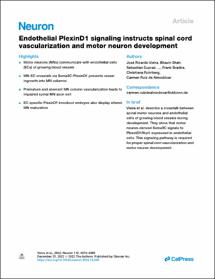Vieira, José Ricardo; Shah, Bhavin; Dupraz, Sebastian; Paredes, Isidora; Himmels, Patricia; Schermann, Géza; Adler, Heike; Motta, Alessia; Gärtner, Lea; Navarro-Aragall, Ariadna; Ioannou, Elena; Dyukova, Elena; Bonnavion, Remy; Fischer, Andreas; Bonanomi, Dario; Bradke, Frank; Ruhrberg, Christiana; Ruiz de Almodóvar, Carmen: Endothelial PlexinD1 signaling instructs spinal cord vascularization and motor neuron development. In: Neuron. 2022, vol. 110, iss. 24, 4074-4089.
Online-Ausgabe in bonndoc: https://hdl.handle.net/20.500.11811/10795
Online-Ausgabe in bonndoc: https://hdl.handle.net/20.500.11811/10795
@article{handle:20.500.11811/10795,
author = {{José Ricardo Vieira} and {Bhavin Shah} and {Sebastian Dupraz} and {Isidora Paredes} and {Patricia Himmels} and {Géza Schermann} and {Heike Adler} and {Alessia Motta} and {Lea Gärtner} and {Ariadna Navarro-Aragall} and {Elena Ioannou} and {Elena Dyukova} and {Remy Bonnavion} and {Andreas Fischer} and {Dario Bonanomi} and {Frank Bradke} and {Christiana Ruhrberg} and {Carmen Ruiz de Almodóvar}},
title = {Endothelial PlexinD1 signaling instructs spinal cord vascularization and motor neuron development},
publisher = {Elsevier},
year = 2022,
month = dec,
journal = {Neuron},
volume = 2022, vol. 110,
number = iss. 24,
pages = 4074--4089,
note = {How the vascular and neural compartment cooperate to achieve such a complex and highly specialized structure as the central nervous system is still unclear. Here, we reveal a crosstalk between motor neurons (MNs) and endothelial cells (ECs), necessary for the coordinated development of MNs. By analyzing cell-to-cell interaction profiles of the mouse developing spinal cord, we uncovered semaphorin 3C (Sema3C) and PlexinD1 as a communication axis between MNs and ECs. Using cell-specific knockout mice and in vitro assays, we demonstrate that removal of Sema3C in MNs, or its receptor PlexinD1 in ECs, results in premature and aberrant vascularization of MN columns. Those vascular defects impair MN axon exit from the spinal cord. Impaired PlexinD1 signaling in ECs also causes MN maturation defects at later stages. This study highlights the importance of a timely and spatially controlled communication between MNs and ECs for proper spinal cord development.},
url = {https://hdl.handle.net/20.500.11811/10795}
}
author = {{José Ricardo Vieira} and {Bhavin Shah} and {Sebastian Dupraz} and {Isidora Paredes} and {Patricia Himmels} and {Géza Schermann} and {Heike Adler} and {Alessia Motta} and {Lea Gärtner} and {Ariadna Navarro-Aragall} and {Elena Ioannou} and {Elena Dyukova} and {Remy Bonnavion} and {Andreas Fischer} and {Dario Bonanomi} and {Frank Bradke} and {Christiana Ruhrberg} and {Carmen Ruiz de Almodóvar}},
title = {Endothelial PlexinD1 signaling instructs spinal cord vascularization and motor neuron development},
publisher = {Elsevier},
year = 2022,
month = dec,
journal = {Neuron},
volume = 2022, vol. 110,
number = iss. 24,
pages = 4074--4089,
note = {How the vascular and neural compartment cooperate to achieve such a complex and highly specialized structure as the central nervous system is still unclear. Here, we reveal a crosstalk between motor neurons (MNs) and endothelial cells (ECs), necessary for the coordinated development of MNs. By analyzing cell-to-cell interaction profiles of the mouse developing spinal cord, we uncovered semaphorin 3C (Sema3C) and PlexinD1 as a communication axis between MNs and ECs. Using cell-specific knockout mice and in vitro assays, we demonstrate that removal of Sema3C in MNs, or its receptor PlexinD1 in ECs, results in premature and aberrant vascularization of MN columns. Those vascular defects impair MN axon exit from the spinal cord. Impaired PlexinD1 signaling in ECs also causes MN maturation defects at later stages. This study highlights the importance of a timely and spatially controlled communication between MNs and ECs for proper spinal cord development.},
url = {https://hdl.handle.net/20.500.11811/10795}
}






